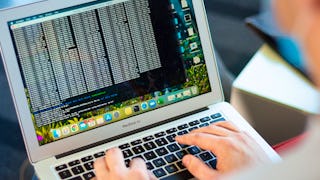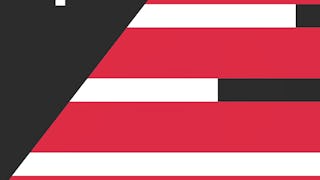Prêt à plonger dans le monde du matériel et des systèmes d'exploitation ? Ce cours adapté aux débutants permet d'acquérir les compétences de base nécessaires pour occuper des postes dans l'assistance informatique, la mise en réseau, la cybersécurité et le développement de logiciels.

Profitez d'une croissance illimitée avec un an de Coursera Plus pour 199 $ (régulièrement 399 $). Économisez maintenant.

Introduction au matériel et aux systèmes d’exploitation
Ce cours fait partie de plusieurs programmes.

Instructeur : IBM Skills Network Team
90 042 déjà inscrits
Inclus avec
(2,027 avis)
Expérience recommandée
Ce que vous apprendrez
Identifier les composants matériels des ordinateurs de bureau, des ordinateurs portables et d'autres appareils, ainsi que les fonctions du système d'exploitation, les paramètres et les processus de dépannage
Explorer les ports, les connecteurs, les dispositifs de stockage et les architectures GPU, et évaluer les solutions matérielles et de traitement appropriées pour les applications
Élaborer des stratégies d'intégration IoT sécurisées pour les dispositifs portables et les smart tech, en utilisant des principes efficaces de gestion des dispositifs et de cybersécurité.
Évaluer les technologies de RV et de RA pour une utilisation organisationnelle, en évaluant les exigences matérielles, les considérations de déploiement et les applications pratiques.
Compétences que vous acquerrez
- Catégorie : Systèmes de fichiers
- Catégorie : Infrastructure réseau
- Catégorie : Installation du logiciel
- Catégorie : Linux
- Catégorie : Comptes d'utilisateurs
- Catégorie : Systèmes d'Exploitation
- Catégorie : Reprise après sinistre
- Catégorie : Matériel informatique
- Catégorie : USB
- Catégorie : Architecture des ordinateurs
- Catégorie : Configuration du système
- Catégorie : Support technique
- Catégorie : Mac OS
- Catégorie : Périphériques
- Catégorie : Dépannage du matériel
- Catégorie : Virtualisation et machines virtuelles
- Catégorie : Machines virtuelles
- Catégorie : Systèmes informatiques
- Catégorie : Écrans d'ordinateur
- Catégorie : Stockage des données
Détails à connaître

Ajouter à votre profil LinkedIn
12 devoirs
Découvrez comment les employés des entreprises prestigieuses maîtrisent des compétences recherchées

Élaborez votre expertise du sujet
- Apprenez de nouveaux concepts auprès d'experts du secteur
- Acquérez une compréhension de base d'un sujet ou d'un outil
- Développez des compétences professionnelles avec des projets pratiques
- Obtenez un certificat professionnel partageable

Il y a 7 modules dans ce cours
Bienvenue dans votre premier module ! À l'issue de ce module, vous serez en mesure de définir ce qu'est un ordinateur. Vous découvrirez les quatre fonctions de l'informatique, les éléments d'un ordinateur associés à chacune de ces fonctions et les avantages de l'informatique. Vous apprendrez à classer les appareils informatiques en fonction de leur taille et de leur utilisation et vous décrirez l'évolution des systèmes d'exploitation. Découvrez comment les ordinateurs communiquent en utilisant des systèmes notationnels (numériques) pour le traitement et le stockage des données, l'affichage de texte à l'écran, les adresses matérielles, les couleurs des sites web et les adresses web. Explorez également les principes de la notation octale pour résoudre les autorisations de fichiers et effectuer des conversions de numérotation. Vous acquerrez les connaissances pratiques nécessaires pour évaluer les performances informatiques et le stockage. Vous connaîtrez les quatre façons de vous connecter à Microsoft Windows, serez capable de décrire comment utiliser le menu Démarrer, les tuiles, la barre des tâches et les fonctionnalités de paramétrage, et serez capable d'expliquer comment gérer Windows sur le bureau. Vous terminerez votre semaine par un laboratoire où vous localiserez des programmes et naviguerez dans Windows pour trouver des informations importantes sur l'ordinateur et le système d'exploitation Windows.
Inclus
7 vidéos2 lectures2 devoirs1 élément d'application1 sujet de discussion1 plugin
Le matériel informatique est l'ensemble des pièces physiques qui composent l'intérieur de votre ordinateur. Les périphériques sont des pièces de matériel qui sont ajoutées à l'extérieur de l'ordinateur pour lui permettre de fonctionner plus efficacement. Le matériel et les périphériques sont tous deux utilisés pour recevoir des entrées, stocker des données, afficher des sorties et exécuter des commandes. Cette semaine, vous découvrirez plusieurs types de composants matériels et de périphériques. Vous découvrirez les imprimantes et les scanners, les périphériques d'entrée et de sortie, les périphériques de stockage externes et les périphériques audio et vidéo. Vous aurez un aperçu des écosystèmes de l'Internet des objets (IoT), y compris les appareils en réseau, la technologie portable et l'intégration des équipements intelligents. Les appareils spécialisés tels que les lecteurs électroniques et leurs technologies d'affichage uniques font l'objet d'une attention particulière.
Inclus
8 vidéos1 lecture2 devoirs3 éléments d'application2 plugins
Les multiples composants d'un ordinateur, tant internes qu'externes, interagissent constamment les uns avec les autres pour recevoir des données d'entrée, exécuter les fonctions informatiques requises et fournir des données de sortie. Grâce à l'évolution de la technologie et à la normalisation des méthodes de connexion, un grand nombre de périphériques externes peuvent aujourd'hui se connecter facilement et avec succès aux ordinateurs et exécuter leurs tâches en toute fiabilité. Cette semaine, vous apprendrez comment le matériel et les périphériques se connectent pour former un ordinateur fonctionnel. Vous découvrirez les ports, les interfaces et les connecteurs utilisés par les périphériques graphiques, audio, réseaux, imprimantes et autres. Vous découvrirez également les types d'installations que ces périphériques utilisent pour devenir opérationnels. En outre, vous examinerez les unités de traitement graphique (GPU), du matériel graphique aux moteurs de traitement parallèle qui alimentent les jeux, l'IA et le calcul scientifique. Le module explore également les technologies de réalité virtuelle (VR) et de réalité augmentée (AR), en mettant l'accent sur la gestion informatique pratique, les protocoles de sécurité et les considérations de mise en œuvre.
Inclus
8 vidéos1 lecture2 devoirs2 éléments d'application1 plugin
Le matériel informatique, la partie physique d'un ordinateur, est rarement modifié, alors que les logiciels et les données le sont fréquemment. Lorsque vous évoquez le terme "matériel informatique", vous pensez probablement à ce qui se trouve à l'intérieur de votre ordinateur personnel à la maison ou de votre ordinateur au travail. Cependant, le matériel informatique ne se réfère pas spécifiquement aux ordinateurs personnels. Il s'agit plutôt de tous les types de systèmes informatiques. Le matériel informatique se trouve dans les systèmes intégrés des automobiles, des fours à micro-ondes, des lecteurs de CD, des lecteurs de DVD et de bien d'autres appareils. Dans cette leçon, vous découvrirez les composants internes courants des systèmes informatiques domestiques et professionnels.
Inclus
6 vidéos1 lecture2 devoirs2 éléments d'application1 plugin
L'installation des postes de travail, la configuration du système d'exploitation et le dépannage des postes de travail font partie des tâches quotidiennes de l'assistance informatique. Qu'il s'agisse de sélectionner un nouvel ordinateur pour un collègue, de reconfigurer un système d'exploitation pour répondre aux besoins d'accessibilité d'un collègue ou de résoudre un problème de visibilité de fichiers ou de répertoires, le personnel du support informatique a besoin de procédures qui l'aident à accomplir ces tâches rapidement, en toute confiance et correctement. Cette semaine, vous acquerrez des connaissances sur l'approvisionnement des postes de travail et sur la configuration et la gestion de base du système d'exploitation Windows. Vous découvrirez des techniques qui vous aideront à optimiser l'organisation des fichiers et des dossiers et peut-être même à aider les utilisateurs à localiser les fichiers cachés. Vous apprendrez des commandes clavier qui vous feront gagner du temps pour capturer des écrans à l'aide de postes de travail Windows 10, de postes de travail macOS et de Chromebooks. Vous compléterez votre apprentissage par un aperçu des principes de continuité des activités utilisés pour la tolérance aux pannes et la reprise après sinistre.
Inclus
10 vidéos1 lecture3 devoirs2 éléments d'application3 plugins
Dans ce module, vous évaluerez vos connaissances à l'aide d'un quiz final basé sur les cinq modules précédents.
Inclus
2 vidéos2 lectures1 devoir1 élément d'application2 plugins
Bienvenue dans votre module bonus ! Bien que Microsoft Windows domine le marché des systèmes d'exploitation de bureau, les organisations utilisent également des ordinateurs qui exécutent les systèmes d'exploitation Linux, macOS et ChromeOS. Et de nombreuses organisations prennent également en charge les utilisateurs qui possèdent des appareils utilisant les systèmes d'exploitation mobiles iOS et Android. À l'issue de ce module, vous serez en mesure d'expliquer pourquoi les organisations prennent en charge ces systèmes d'exploitation alternatifs. Vous serez en mesure de comparer et de contraster les processus de connexion aux systèmes d'exploitation, les méthodes de connexion au réseau, la navigation à l'écran, les menus et les fonctionnalités. Ce module explore les concepts informatiques essentiels et les technologies émergentes qui définissent les environnements informatiques modernes. L'exploration de la technologie de virtualisation comprend les systèmes d'exploitation hôte/invité et les implémentations d'hyperviseurs. Vous acquerrez également les connaissances nécessaires pour expliquer où chaque système d'exploitation stocke les identifiants des périphériques, les informations sur les versions et les paramètres du système. Approfondissez et développez vos compétences en matière de Linux en utilisant le laboratoire Linux.
Inclus
7 vidéos1 lecture1 élément d'application1 plugin
Obtenez un certificat professionnel
Ajoutez ce titre à votre profil LinkedIn, à votre curriculum vitae ou à votre CV. Partagez-le sur les médias sociaux et dans votre évaluation des performances.
Instructeur

Offert par
En savoir plus sur Support et exploitation
 Statut : Prévisualisation
Statut : Prévisualisation Statut : Prévisualisation
Statut : Prévisualisation Statut : Essai gratuit
Statut : Essai gratuitMicrosoft
 Statut : Essai gratuit
Statut : Essai gratuit
Pour quelles raisons les étudiants sur Coursera nous choisissent-ils pour leur carrière ?




Avis des étudiants
2 027 avis
- 5 stars
76,76 %
- 4 stars
18,40 %
- 3 stars
3,10 %
- 2 stars
0,74 %
- 1 star
0,98 %
Affichage de 3 sur 2027
Révisé le 12 juin 2025
This course is helped my accademics. I improved hardware and operating system knowledge. simulator desktop is more valuable for understand better. It gave prictically background as well.
Révisé le 16 juil. 2022
very well organized, and I liked that videos were short but numerous enough to articulate the different facets individually
Révisé le 2 juil. 2024
Understanding these basics will help me effectively use, maintain, and troubleshoot computers and their operating systems.
Foire Aux Questions
Pour accéder aux supports de cours, aux devoirs et pour obtenir un certificat, vous devez acheter l'expérience de certificat lorsque vous vous inscrivez à un cours. Vous pouvez essayer un essai gratuit ou demander une aide financière. Le cours peut proposer l'option "Cours complet, pas de certificat". Cette option vous permet de consulter tous les supports de cours, de soumettre les évaluations requises et d'obtenir une note finale. Cela signifie également que vous ne pourrez pas acheter un certificat d'expérience.
Lorsque vous vous inscrivez au cours, vous avez accès à tous les cours du certificat et vous obtenez un certificat lorsque vous terminez le travail. Votre certificat électronique sera ajouté à votre page Réalisations - à partir de là, vous pouvez imprimer votre certificat ou l'ajouter à votre profil LinkedIn.
Plus de questions
Aide financière disponible,





